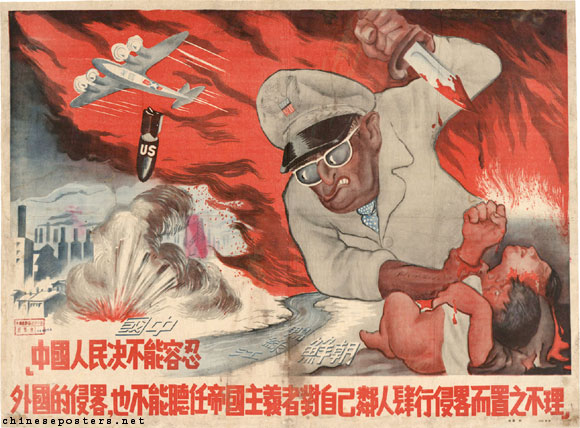I WANT YOU!
Originally published as the cover for the July 6, 1916, issue of Leslie’s Weekly with the title “What Are You Doing for Preparedness?” this portrait of “Uncle Sam” went on to become–according to its creator, James Montgomery Flagg–”the most famous poster in the world.” Over four million copies were printed between 1917 and 1918, as the United States entered World War I and began sending troops and material into war zones.
We Can Do It!
We Can Do It! is a WW II era American wartime propoganda poster produced by J. Howard Miller in 1943 for Westinghouse Electric as a tool to boost worker morale. Surprisingly, the poster did not enjoy wide popularity during World War II. It was rediscovered in the early 1980s and widely reproduced in many forms, often called “We Can Do It!” but also mistakenly called “Rosie the Riveter” after the iconic figure of a strong female war production worker. The “We Can Do It!” image was used to promote feminism and other political issues beginning in the 1980?s. After its rediscovery, people often assumed that the image was always meant to be a call to inspire women workers to join the war effort. However, during the war the image was strictly internal to Westinghouse, displayed only during February 1943, and was not for recruitment but to inspire already-hired women to work harder.
Open Trap, Make Happy Jap
Reflecting the ugly racism of the times, many US produced propaganda posters from World War II would typecast the Japanese as goofy and cartoonish stereotypes. Buck teeth, big ears and an exaggeration on the eyes were recurring features. This incredibly racist image reflects our powerful need to dehumanize the enemy before we slaughter them, making the carnage not seem so evil.
Xu Ling: China
Details about Chinese artists are hard to come by, but we can focus on what they intended to convey with their artwork. This piece is a caricature of the American commander in Korea at that time, General Douglas MacArthur. It shows the US as an abhorrent evil, and MacArthur is shown stabbing a Korean mother and child. Bombs labeled US are being dropped on cities in China in the background as the US invades Korea.
"Liberators"
The Nazi’s had a very imaginative approach when it came to producing posters during the Second World War. Designed by Norwegian cartoonist Harald Damsleth, this particularly famous image depicts the Americans as a domineering force and characterizes many of their supposedly negative aspects, such as being money grabbing, racist, over-sexualized and all-empowering.
North and South United
This poster asks for peace between the North and South of Vietnam, to protect the country from destruction and war.
Lenin lived, Lenin lives, Lenin will live forever!
“In the name of peace”
Buy War Bonds
Encouraging people to buy war bonds was an incredibly popular propaganda message, and an example can be seen here. It shows three children underneath a shadow of the Nazi symbol, along with the message ‘don’t let that shadow touch them, buy war bonds’. This message implies that if you don’t support the war financially, harm could come to your children, playing on people’s fear. It was incredibly successful.
Together
This poster was created in Britain during WWII. It shows an array of different types of British citizens all coming together in a time of need. The ideas of race and class are completely disregarded, and it encourages everyone to come together and help their country.
Looking for Hope
Another Nazi poster, this one shows starving and homeless Germans, and has the message that Hitler is their only hope for survival (“unsere letzte hoffnung: Hitler” means “Our last hope: Hitler.”)
Build Tanks
This poster encourages Russians to help the country build more tanks in order to defeat Nazi Germany. It shows both a man and a woman looking out into space. They look strong and hopeful, giving Russian citizens hope that the war will come to an end.
The Emancipation of Russian Women
Another Russian poster, this one shows the emancipation of Russian women. Instead of showing her in the workforce, they defeminized her, making her look like a man. This in turn made the poster into an effort to increase labor in both men and women.
Socialism Throttling The Country
This poster was commissioned by the
Conservative Party in Britain in 1909. It depicted the “beast” of
socialism endangering the plight of British prosperity.
Lick Them Over There!
Canada officially entered the Second World War on 10 September, 1939. This poster, designed to encourage Canadian men to join the fight in Europe, used the imagery of the soldier with one foot in Canada and one in Europe to symbolize the pressing threat on national security.
Manchukuo
This propaganda poster promotes harmony between the Japanese, Chinese, and Manchu peoples. Their flags are in the background, and the caption reads ‘with the cooperation of Japan, China, and Manchukuo the world can be in peace.’ The people look happy and peaceful, and are linking arms in camaraderie.
Death and Fascism
This poster reads ‘The world now knows
that the Fascists have nothing to offer the youth but death.’ It shows a
skeleton removing a mask, which is the face of Hitler, and alludes to
the fall of the Nazi regime.



















Comments
Post a Comment